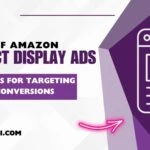What you’ll learn
Mastering Amazon advertising metrics is the key to achieving success in the ultra-competitive world of online retail.
As sellers on the platform, we must understand and utilize these metrics to optimize our advertising campaigns and drive sales. By analyzing data and making informed decisions, we can elevate our brand visibility, increase conversions, and maximize return on investment.
In today’s data-driven landscape, it is crucial to have a deep understanding of key metrics such as click-through rate (CTR), conversion rate (CR), average cost of sales (ACoS), return on ad spend (ROAS), ad impressions, and ad placement.
As sellers navigating Amazon’s vast marketplace, mastering these advertising metrics paves the way for success by enabling data-backed decision-making that optimizes our campaigns.
By leveraging these insights, we can establish a sense of belonging within the competitive landscape and achieve our goals of increased sales and brand recognition.
Click-Through Rate (CTR) and Its Importance

Do you know how important click-through rate (CTR) is in determining the success of your Amazon advertising campaign?
Click-through rate, or CTR, is a crucial metric measuring the percentage of ad clicks per impression. It provides prized insights into the effectiveness of your Amazon ads and helps you make informed decisions to optimize your campaigns.
As advertisers, we strive for high CTRs because they indicate that our ads are engaging and attract potential customers’ attention.
When analyzing advertising metrics, click-through rate (CTR) stands out as a key indicator of performance. A higher CTR signifies that a larger proportion of users who view your ad are actually clicking on it, showing genuine interest in your product or service. This directly affects the success of your Amazon advertising campaign by driving more traffic to your listings and increasing the likelihood of conversions.
By monitoring CTR closely, you can identify which ads resonate with your target audience and allocate resources accordingly.
To improve click-through rate (CTR), consider optimizing elements such as ad copy, keywords, and targeting strategies. Crafting compelling headlines and descriptions highlighting unique selling points can entice users to click on your ads.
Additionally, thorough keyword research ensures that your ads appear in relevant search results, increasing their visibility to interested shoppers.
Fine-tuning targeting settings allows you to reach specific demographics or geographic locations where potential customers are most likely to convert. This will help you quickly achieve your business goals.
Conversion Rate (CR) and Its Impact on Sales

Boost your sales by improving your conversion rate, and watch the magic happen! The conversion rate is a crucial metric that calculates the percentage of customers who make a purchase after clicking on your ad. It directly impacts the sales generated from your advertising efforts.
A higher conversion rate means more customers are taking action and buying your products, resulting in increased revenue for your business. Improving your conversion rate can have a strong impact on your total sales.
By analyzing data and understanding customer behavior, you can optimize your product listings, ad campaigns, and targeting strategies to increase conversions.
A well-optimized listing with compelling images, persuasive product descriptions, and positive customer reviews can greatly influence a shopper’s buying decision. Refining your targeting parameters to reach the right audience at the right time can further improve conversions.
Furthermore, focusing on improving your conversion rate can also help reduce the advertising cost of sales (ACOS) and maximize profit margins. When more customers convert after clicking on an ad, you’re effectively utilizing your advertising budget to generate sales.
This means you’re spending less money on ads that don’t lead to purchases. You achieve a better return on investment (ROI) by increasing conversions without significantly increasing ad spend.
Average Cost of Sales (ACoS) and Budget Allocation
Maximizing profit margins and effectively allocating our budget are key factors in achieving a lower average cost of sales (ACoS).
A lower ACoS indicates that we’re generating more sales for every advertising dollar spent, ultimately leading to higher profitability. To achieve this, it’s important to carefully analyze our advertising metrics and make informed decisions regarding budget allocation.
When considering budget allocation, there are several factors to take into account. Firstly, we must assess the performance of different advertising campaigns and channels.
By analyzing the return on ad spend (ROAS) for each campaign, we can identify which ones are driving the highest sales at the lowest cost. This allows us to allocate more budget towards these high-performing campaigns while reducing spending on underperforming ones.
Secondly, consider the impact of increasing or decreasing our advertising spend on sales volume and ACoS. It’s crucial to strike a balance between investing enough in advertising to drive sales growth without overspending and negatively affecting our profitability.
In terms of specific tactics for optimizing ACoS through budget allocation, a few strategies can be effective. First, focusing on highly relevant keywords with strong conversion rates can help improve ad performance and reduce ACoS.
🗣️ Pro Tip: Budget for performance of your different ad campaigns.
By targeting keywords with high purchase intent and aligning them with relevant product listings, we increase the likelihood of conversions and generate better returns on our ad spend.
Second, leveraging sponsored brand ads can be beneficial as they often deliver higher visibility and click-through rates compared to other ad formats.
Allocating a portion of our budget towards sponsored brands ads can help drive more traffic and increase overall sales while still maintaining a reasonable ACoS.
Effectively managing budget allocation plays a vital role in achieving a lower average cost of sales (ACoS). We can optimize our advertising efforts and increase profitability by analyzing advertising metrics such as return on ad spend (ROAS) and strategically allocating funds based on campaign performance.
Additionally, focusing on relevant keywords and leveraging sponsored brand ads can enhance ad performance and drive sales growth while maintaining a reasonable ACoS.
Return on Ad Spend (ROAS) and Maximizing ROI

When it comes to measuring the success of Amazon ads, Return on Ad Spend (ROAS) is a crucial metric. It quantifies the revenue generated from each dollar spent on advertising, allowing sellers to assess the effectiveness of their campaigns.
To maximize ROI, it’s important to determine what constitutes a good ROAS in Amazon ads by analyzing historical data and industry benchmarks.
How Much ROAS is Good in Amazon Ads?
Achieving a solid return on ad spend (ROAS) is crucial for success in Amazon advertising. It’s the metric that measures the effectiveness of our ad campaigns and determines if we’re getting a positive ROI.
But how much ROAS is considered good in Amazon ads? Let’s dive into the data to find out.
- Click Through Rate (CTR): A high CTR indicates that our ads are resonating with customers and driving them to click on our products. This ultimately leads to higher sales and better ROAS.
- Ad Campaigns: Monitoring the performance of individual ad campaigns allows us to identify which ones generate the most advertising sales. By optimizing these successful campaigns, we can increase our overall ROAS.
- Campaign Reporting: Regularly reviewing campaign reports provides valuable insights into which keywords, placements, and targeting strategies perform well. This helps us make data-driven decisions and improve our ROAS over time.
- Advertising Money: Maximizing ROAS means getting the most out of every advertising dollar spent. We can allocate our advertising budget more effectively by analyzing cost per click (CPC), conversion rates, and other key metrics.
- Precise Targeting: Reaching the right audience is essential for achieving a good ROAS. We can increase conversion rates and boost our overall ROI by narrowing down our target audience based on demographics, interests, or previous purchase behavior.
By focusing on these key factors and continuously optimizing our Amazon ads strategy, we can aim for a higher ROAS.
Remember that achieving an excellent return on ad spend and improving Amazon PPC metrics don’t happen overnight; it requires constant monitoring, analysis, and adjustment to stay ahead of the competition.
Ad Impressions and Increasing Visibility
Increasing visibility on Amazon is like turning on a bright spotlight that attracts potential customers and illuminates your products. Ad impressions are a key metric to consider when it comes to increasing visibility. Ad impressions refer to the number of times your ad is displayed to potential customers.
The more impressions your ad receives, the higher the chances of it being seen by users searching for relevant products. Increasing the number of impressions can directly impact your organic ranking and overall visibility in search results.
When your ad frequently appears in search results, it increases the likelihood of clicks and conversions and signals to Amazon’s algorithm that your product is popular and relevant. This can improve organic rankings, further boosting your visibility without relying solely on paid advertising.
To increase ad impressions and overall visibility, optimizing your campaigns with targeted keywords, compelling ad copy, and relevant product images is essential.
🗣️ Pro Tip: Increase impressions & visibility with keyword research & great images.
By using data-driven insights and analyzing the performance of different keywords or variations of ads, you can refine your strategy to maximize impressions while maintaining a good return on investment.
Additionally, leveraging Amazon’s sponsored brands or sponsored display ads can help expand reach beyond traditional search results pages. Focusing on increasing ad impressions plays a vital role in enhancing visibility on Amazon. It helps attract potential customers and improves organic rankings and overall presence in search results.
Ad Placement and Its Effect on Performance

There are three primary types of Amazon PPC ads: Sponsored Products, Brands, and Display. Each type of ad serves a different purpose and can be used to target specific goals.
Sponsored Products ads allow sellers to promote individual products in search results, while Sponsored Brands ads showcase a brand’s logo and multiple products.
Lastly, Sponsored Display ads are used to reach customers both on and off Amazon through product targeting or audience targeting.
Understanding the different types of ads available can help sellers create effective advertising strategies and improve PPC metrics based on their specific objectives.
How Many Types of Amazon PPC Ads Are There?
Start by understanding the various types of Amazon PPC ads available to you. When it comes to advertising on Amazon, there are several ad types that you can choose from to promote your products and drive traffic to your listings.
The most common types include Sponsored Brands, Sponsored Products, and Product Display Ads. Sponsored products are the most sought-after ad type on Amazon.
These ads appear within search results and on product detail pages, allowing you to target specific keywords or products. They’re a great way to increase the visibility of your products and increase sales.
Sponsored Brands, however, allow you to showcase multiple products in a single ad unit while promoting your brand logo and custom headline. These ads usually appear at the top of search results and help build brand awareness.
Lastly, Product Display Ads target shoppers who are already viewing related products or categories. These ads can be highly effective for cross-selling or upselling. Understanding each ad type is crucial because it allows you to modify your campaigns based on their specific objectives and targeting options.
You can maximize your reach and optimize your advertising spend by utilizing different ad types strategically.
Final Words
Mastering Amazon advertising metrics is the key to success. By understanding the metrics that matter, you can track the performance of your campaigns and make necessary adjustments to improve your results.
Some of the most important metrics to track include advertising cost of sales (ACoS), conversion rate (CR), and return on ad spend (ROAS). By tracking these metrics, you can see how your campaigns are performing and identify areas where you can improve.
Comments
Related Posts

10 Profitable Product Categories for Amazon Affiliates 2025
What you’ll learn Amazon is a favorite for experienced and…

Unlock the Secret to a Profitable Automated Amazon Store: How to Build a Hands-Free Income Stream
Ever dreamed of running a profitable Amazon business while sipping…

Master Amazon New Restricted Keywords: A Seller’s Guide to Success
Changes to Amazon’s restricted keywords list have taken a lot…







Leave a Reply